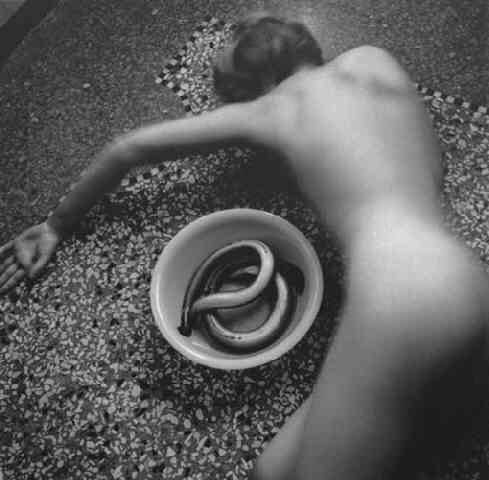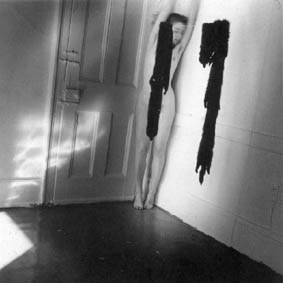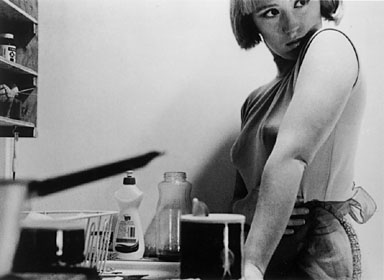So, I haven't been feeling all that inspired with the self-portraiture assignments. Although I really loved the work of many of the artists we've talked about, I don't feel that much of a connection to any of them.
For instance, I have always liked Frida Kahlo's work, but it inspires me more as a painter than a photographer.

I was completely amazed by Francesca Woodman, as well, mostly just because of the incredible way she uses the shape of the body and other objects in such an abstract way. I particularly liked this image:

The circular movement of the image and her body is amazing, really emphasizing the bowl in the center. Your eye cannot help but be drawn to it. The contrast of the white bowl with the very black snake emphasizes the shape even more. Her body, being gray, makes it really almost blend into the rest of the image.
I like this image a lot as well:

I kind of like that, if you look closely, you can see the line holding the articles of clothing or pieces of fabric. The composition is amazing, with the contrast of the black fabric and the very white background. It seems as if the fabric is meant to be hiding her body, or maybe to emphasize the line of her body.
I liked a lot of Cindy Sherman's earlier work, too. It's really mind-blowing how she is able to transform herself through costumes and makeup. It's pretty spectacular.



All the women she's portraying seem to have a very specific story. I think I'm mostly drawn to these particular images because of the era in fashion and history that these costumes are portraying. I really love the one where she's reaching to the bookshelf. The entirely white clothing with the blonde hair creates this ultra-feminine, pure kind of archaic image of a young woman, and her attempting to reach for the books– for knowledge, or education, or self-sufficiency– contradicts that. It seems to say something about the 1960s (maybe late 1950s, as the clothing seems to represent) and the role of women at that time.
While I really like all of the self-portraits of these women, there are a lot of artists who focus on portraits of other people that I really respond to. For instance, in class, we briefly talked about Jospeh Szabo, but I have been familiar with his work for a few years now and I really like his images of teenagers. I love the simplicity of Richard Avedon's portraits, too.
There's one painter, Lori Earley, whose work I have loved for a while now. She is a contemporary, young painter from New York, who studied at SVA. She exclusively paints highly stylized portraits of women, generally in oils. She's had solo exhibitions all over the world, including those in New York, London, Seattle, and L.A.
Here are some examples of her work:




I love the ethereal, emotional, almost haunting quality of her portraits. I think the enlarged eyes really add so much emotion and depth to the women in her portraits. I think it might be really cool to try to recreate the same kind of feeling and energy in my own photographic self-portraiture.































